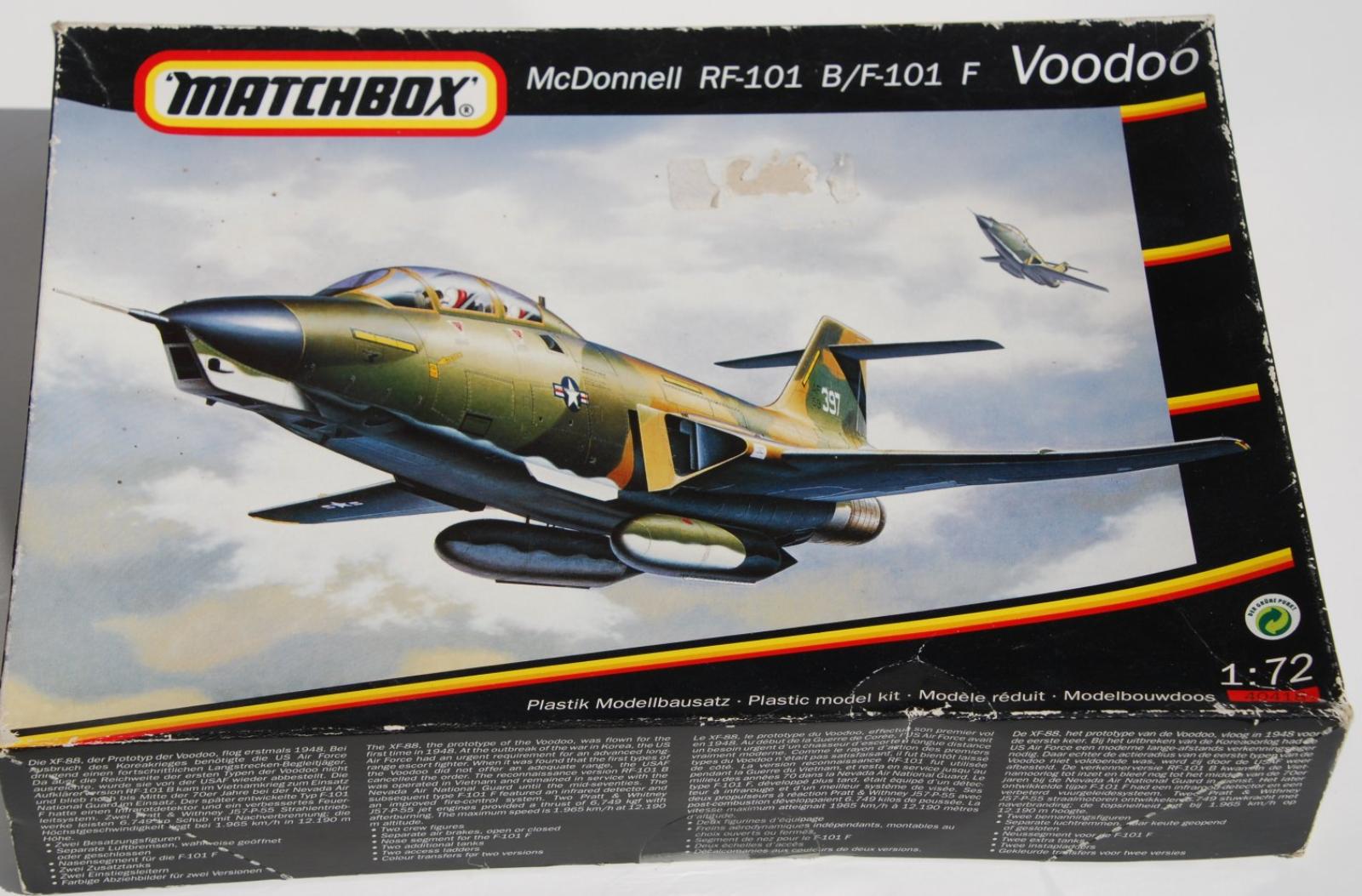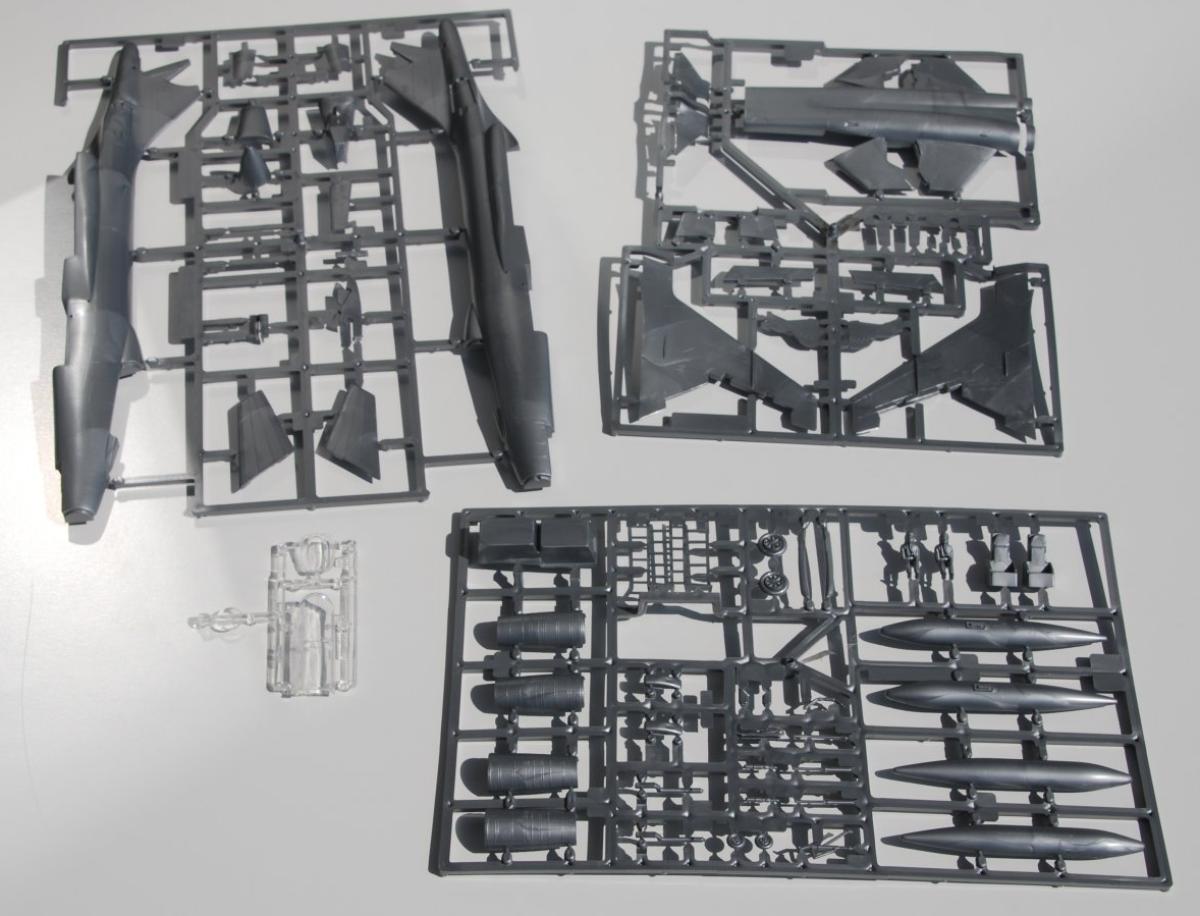Manufacturer: Matchbox
Scale: 1/72
Additional parts: none
Model build: Aug-Oct 2016

Manufacturer: Matchbox
Scale: 1/72
Additional parts: none
Model build: Aug-Oct 2016
November, 1962. Baltic Sea
Leutnant Erich Kessler tightened his grip on the control stick, his knuckles white. The frigid air leaking through the canopy seemed to seep into his bones despite his heated flight suit. Below him, the icy Baltic Sea stretched out like a frozen wasteland, mirroring the steely gray sky above. His RF-101 Voodoo, a sleek black arrow against the bleak landscape, hummed with the thrum of its powerful engines. Today's mission was unlike any he'd flown before. Intel suggested a large Soviet fleet gathering near Kaliningrad, a potential storm brewing on the horizon. Erich's job? Get a peek behind the Iron Curtain and photograph the enemy.
The tension crackled in the cockpit. His navigator, Oberleutnant Strauss, monitored the radar with a hawk-like focus. "Erich," Strauss' voice crackled over the intercom, "early warning system just picked up bogey contacts. Two MiG-17s, closing fast."
Erich cursed under his breath. The RF-101 wasn't built for dogfights. Sure, it could outrun most anything on the eastern side of the border, but its maneuverability was its Achilles' heel. He slammed the throttles forward, the jet straining as it clawed for altitude. A glance in the rearview mirror confirmed his fears - two tiny silver specks growing rapidly against the pale sky.
He pushed the Voodoo to its limits, weaving a frantic dance through the clouds, the airframe protesting at the violent maneuvers. The MiGs, less agile at high altitude, sputtered in pursuit, their frustration evident in the bursts of cannon fire that bracketed his position. Every nerve in Erich's body screamed at him to break for neutral airspace, but the objective was too important. He needed those photos.
Suddenly, the harsh cackle of the radar warning receiver cut through the tension. "New contact! Large number of unidentified ships… bearing 010!" Strauss yelled. Erich risked a glance down, his breath catching in his throat. Below him, a vast Soviet fleet sliced through the ice-choked water. Cruisers, destroyers, and a hulking carrier dominated the scene, a chilling display of Soviet might.
He knew he only had a few seconds. Ignoring the pulsating MiG threat behind him, Erich expertly maneuvered the Voodoo into a low-level run, skimming the icy waves. The MiGs overshot him, momentarily confused by his daring move. With practiced efficiency, he fired off a burst of photos, capturing the composition of the Soviet fleet in sharp detail.
Just then, the world erupted in flame. One of the MiGs, banking hard to regain pursuit, had misjudged its turn. Its wingtip clipped the icy surface of the sea, sending a fiery fireball skyward. Erich watched momentarily, a morbid fascination gripping him, before forcing himself to focus.
The remaining MiG, its pilot shaken by his comrade's demise, hesitated. Using the brief window, Erich punched the afterburners, the Voodoo screaming in protest as it accelerated towards the safety of West German airspace. The remaining MiG, its thirst for vengeance satiated by the sight of its flaming counterpart, didn't pursue.
Erich landed with a heavy thud hours later, the base lights a beacon in the gathering darkness. His body ached, adrenaline slowly ebbing away. He limped out of the cockpit, a shaky smile playing on his lips. He had his photos, a scoop that could potentially alter the course of the Cold War. And though the mission had pushed him to the edge, it had also ignited a fierce pride within him. He was a pilot of the fledgling Luftwaffe, and he, along with his sleek black bird, had defied the odds and stared down the Soviet bear in its own den.

When the newly formed Bundesluftwaffe took to the skies in the mid-1950s, its first dedicated reconnaissance aircraft was the RF-84F Thunderflash. Although reliable and easy to maintain, it soon became apparent that the aircraft’s maximum speed of barely Mach 1.0 left it dangerously vulnerable to increasingly sophisticated Soviet air defenses.
By 1959, Luftwaffe command concluded that a high-speed, long-range reconnaissance platform was urgently required—especially for Baltic surveillance, Warsaw Pact troop monitoring, and nuclear strike reconnaissance preparations. After negotiations with the United States, West Germany placed an order for 18 McDonnell RF-101C Voodoo aircraft.
Three aircraft were transferred directly from USAF stock, and the remaining 15 were newly built to Luftwaffe specifications. The first German-crewed Voodoo took off from Neuburg Air Base on 12 June 1960.
The RF-101, nicknamed “Rasender Sarg” (Racing Coffin) by its pilots, entered service with Aufklärungsgeschwader 52, stationed at Leck and later Schleswig-Jagel. With a top speed of Mach 1.7 at altitude, it became the fastest operational aircraft in the Bundesluftwaffe—until the Starfighter arrived.
Its primary missions included:
Photographic surveillance of Soviet naval movements in the Baltic.
Monitoring airfields in East Germany, Poland, and the Kaliningrad Oblast.
High-altitude “look-and-dash” runs along the Inner German Border.
Stand-off reconnaissance during NATO exercises such as “Fallex” and “Cold Fire.”
The RF-101’s speed and low-level penetration capability allowed it to survive in environments where the RF-84 would never have returned.
Operating close to Warsaw Pact borders brought numerous incidents—most never officially acknowledged by Bonn:
March 1962 – The Bornholm Intercept:
An RF-101 flying a Baltic patrol was intercepted by two Soviet MiG-19s east of Bornholm. Guns were armed but no shots were fired—the Voodoo descended to wave-top height and escaped into Danish airspace at full afterburner.
November 1965 – Wolgast Incident:
During a low-level flight near the Polish coast, a Voodoo clipped a radio mast while evading a Polish MiG-21. The aircraft made an emergency landing at Schleswig with half its right wingtip missing.
June 1974 – The “Phantom Duel”:
Two East German MiG-21MFs attempted to force an RF-101 to land at Laage Air Base. A pair of West German F-4F Phantoms scrambled from Wittmund to escort it back. No shots were fired, but radio recordings reveal intense tension between both sides.
Between 1960 and 1988, four Luftwaffe RF-101s were lost:
Two crashes during low-level training in the Alps.
One engine explosion during a Baltic mission near Rügen.
One pilot ejected after a dual hydraulic failure near Hohn.
Despite these losses, the Voodoo earned great respect among pilots and technicians alike.
By the mid-1980s, however, the aircraft was technologically outdated. The arrival of the Panavia Tornado ECR and IDS reconnaissance variants made the Voodoo redundant. On 15 March 1988, the RF-101 was officially retired from Bundesluftwaffe service. Several were scrapped, three were sold to museums, and one now stands at the entrance of Fliegerhorst Jagel.
Although overshadowed by the F-104 Starfighter and Tornado, the RF-101 played a crucial—if discreet—role during the most dangerous years of the Cold War. It was the first true high-speed eye of the Bundeswehr, silently photographing the arsenals of the Warsaw Pact while flying at treetop height or at the edge of the stratosphere.
In the memoirs of one Voodoo pilot, a single sentence summarizes its service:
“We saw everything—but had to pretend we were never there.”

The is a 1/72 scale Matchbox kit which is build OOB. Cockpit can be build open or closed, if open, the kit contains two ladders. The model is painted with Revell Aqua Color and decals are taken form the spare part box (the original ones were not usable any more).